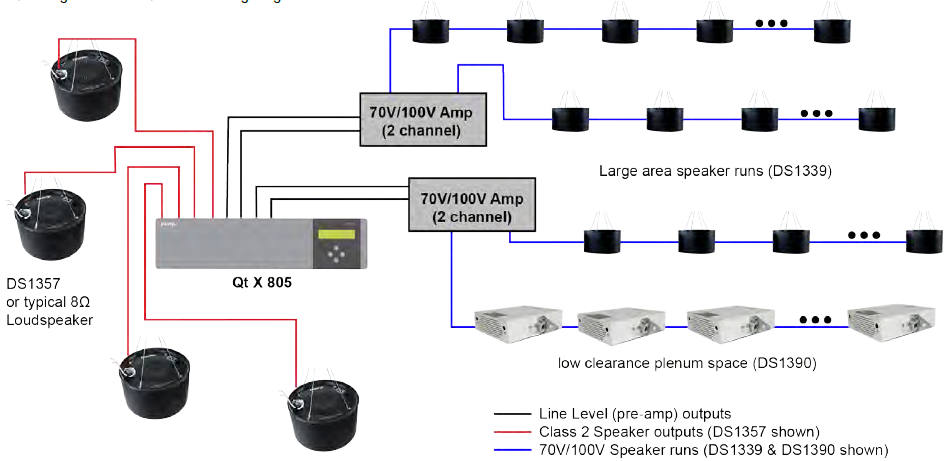Qt X Direct and indirect field speaker comparison
This article compares the types of sound masking emitters and speakers available for the Qt X product family, including emitter and speaker models, their purposes and limitations. Also covered: Which Qt X Controllers these devices are compatible with and wiring considerations for each.
Direct field speakers
Passive Emitters
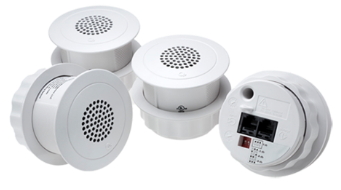 Qt Passive Emitters (Part# E-A-W/B) are wide dispersion direct field passive emitters. The passive emitters are powered by the Qt X controller's output and do not require additional power supplies. The passive emitters are intended for use in Zones with only sound masking and light background music playback and are not intended for Zones with paging or loud background music needs.
Qt Passive Emitters (Part# E-A-W/B) are wide dispersion direct field passive emitters. The passive emitters are powered by the Qt X controller's output and do not require additional power supplies. The passive emitters are intended for use in Zones with only sound masking and light background music playback and are not intended for Zones with paging or loud background music needs.
Each passive emitter comes with three dip switches located at the top for individual speaker signal attenuation, creating transitional areas within a Zone. The level can be dropped in increments of -3 dB up to a maximum of -9 dB.
Cabling
Qt Passive Emitters use CAT-3 cabling or above with RJ-45 connectors to daisy chain emitters back to the Qt X sound masking generator. The top of each emitter has two RJ-45 ports, an input for the signal from the Qt X unit, and an output to chain the next emitter in the run. A single output can contain up to 120 passive emitters, with a maximum of 60 emitters per run, and a maximum cabling distance of 1000' (300 meters) for any individual run.
Supported Qt X controllers
- Qt X 300 and Qt X 300D
- Qt X 600 and Qt X 600D
Active Emitters
Qt Active Emitters (Part# E-P-W/B) are wide dispersion direct field powered emitters. These are intended for use in spaces needing a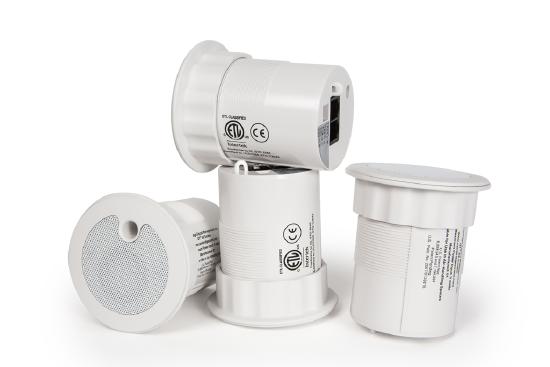 higher level of output than the passive emitters. Active emitters receive a sound masking signal from the Qt X unit they're connected to, but they must also be powered by the PS-AE-3 power supply and a PI-AE power injector. Active emitters can play back sound masking signals at higher levels than passive emitters and also support paging and background music.
higher level of output than the passive emitters. Active emitters receive a sound masking signal from the Qt X unit they're connected to, but they must also be powered by the PS-AE-3 power supply and a PI-AE power injector. Active emitters can play back sound masking signals at higher levels than passive emitters and also support paging and background music.
Each active emitter comes with three dip switches located at the top for individual speaker signal attenuation, creating transitional areas within a Zone. The level can be dropped in increments of -1.5 dB up to a maximum of -4.5 dB.
The DS1320 speaker is an Active Emitter with an adapter for use with Qt X 800 and 800D controllers as well as the Qt X 805 and 805D.
Cabling
Qt Active Emitters use CAT-3 cabling or above with RJ-45 connectors to daisy chain emitters back to the power injector unit, then to 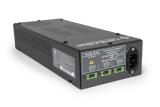 the Qt X sound masking generator. The top of each emitter has two RJ-45 ports, an input for the signal from the Qt X unit, and an output to chain the next emitter in the run. A single output can contain up to 100 active emitters, with a maximum of 50 emitters per run, split further into 25 emitters per output on the power injector, and a maximum cabling distance of 400' (120 meters) from the end of the run back to the power injector.
the Qt X sound masking generator. The top of each emitter has two RJ-45 ports, an input for the signal from the Qt X unit, and an output to chain the next emitter in the run. A single output can contain up to 100 active emitters, with a maximum of 50 emitters per run, split further into 25 emitters per output on the power injector, and a maximum cabling distance of 400' (120 meters) from the end of the run back to the power injector.
The power supply must be plugged into an outlet and has three 2 conductor captive screw(euro connector) outputs to power up to three power injectors using 14/2 AWG 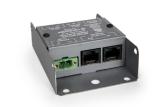 cabling. The cable between the power supply and power injector can be run up to 400' (120 meters) and can be chained between power injectors. A single output on the power supply can power up to 50 active emitters spread across a number of power injectors.
cabling. The cable between the power supply and power injector can be run up to 400' (120 meters) and can be chained between power injectors. A single output on the power supply can power up to 50 active emitters spread across a number of power injectors.
Supported Qt X controllers
- Qt X 300 and Qt X 300D
- Qt X 600 and Qt X 600D
- Qt X 800 and Qt X 800D
- Qt X 805 and Qt X 805D
Indirect field speakers
Low impedance speakers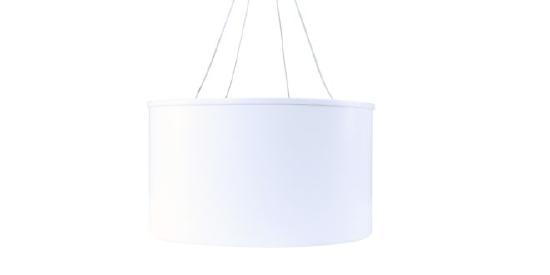
The Qt X 800, 800D, 805, and 805D controllers each have 8 amplified speaker outputs for low impedance speakers (4 or 8 ohms). The speaker outputs support both the DS1357 and the DS1398 model speakers. The low impedance speakers can be used in Zones with any other speaker or emitter type and can support background music or paging along with sound masking.
The DS1357 contains a 5.25-inch diameter speaker designed to be suspended by a four-point suspension system that leads to a central wire in open ceilings or above suspended ceilings.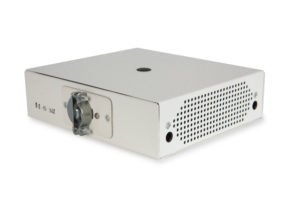
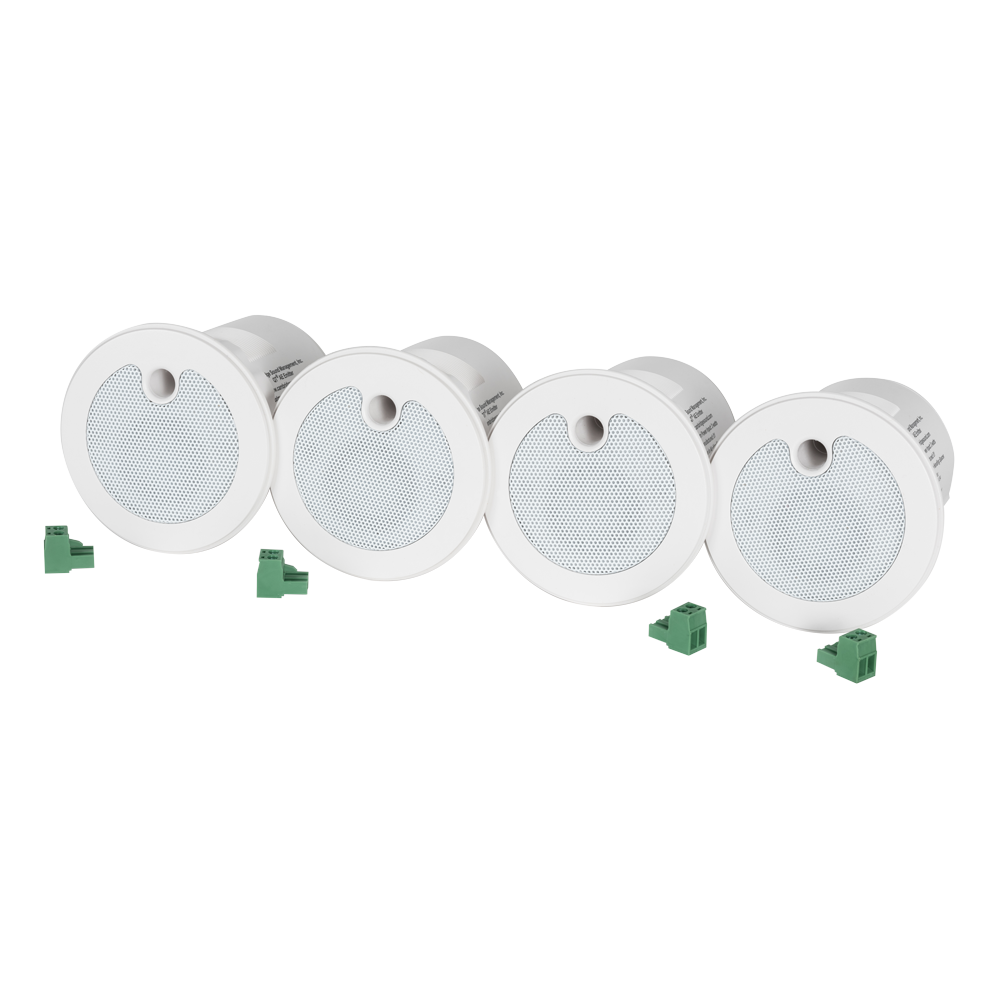
The DS1398 is a dual, horizontally opposed speaker designed to be installed in floor cavities or over ceiling tiles.
The DS1320 speaker is an Active Emitter with an adapter for use with Qt X 800 and 800D controllers as well as the Qt X 805 and 805D
Cabling
Speaker connections are made with a standard two-conductor audio cable (#18 to #16 AWG) and up to two speakers can be daisy-chained off of each output for a total of 16 low impedance speakers per Qt X device.
16 AWG - 55 ft (16.8m)
18 AWG - 40 ft (12.2m)
Supported Qt X controllers
- Qt X 800 and Qt X 800D
- Qt X 805 and Qt X 805D
70V/100V speakers
The Qt X 805 and 805D controllers have 8 additional line-level outputs for use with 70V/100V systems. Each output can control 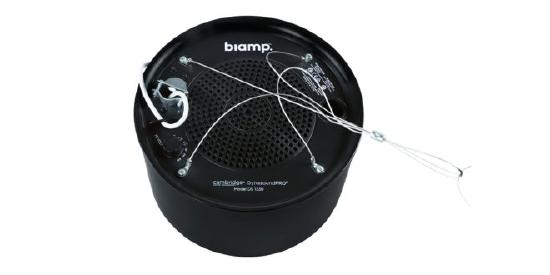 sound masking on a single 70V/100V amplifier channel. Both controllers support a wide range of 70V/100V amplifiers and are flexible to the needs of individual projects as well as a wide range of 70V/100V speakers, including the DS1339 and DS1390. The 70V/100V speakers can be used in Zones with any other speaker or emitter type and can support background music or paging along with sound masking.
sound masking on a single 70V/100V amplifier channel. Both controllers support a wide range of 70V/100V amplifiers and are flexible to the needs of individual projects as well as a wide range of 70V/100V speakers, including the DS1339 and DS1390. The 70V/100V speakers can be used in Zones with any other speaker or emitter type and can support background music or paging along with sound masking.
The DS1339 contains a 5.25-inch diameter speaker designed to be suspended by a four-point suspension system that leads to a central wire in open ceilings or above suspended ceilings. It contains an internal transformer with a tap switch ranging from 1/8 to 4 watts.
The DS1390 is a dual, horizontally opposed speaker designed to be installed in floor cavities or over ceiling tiles. It contains an internal 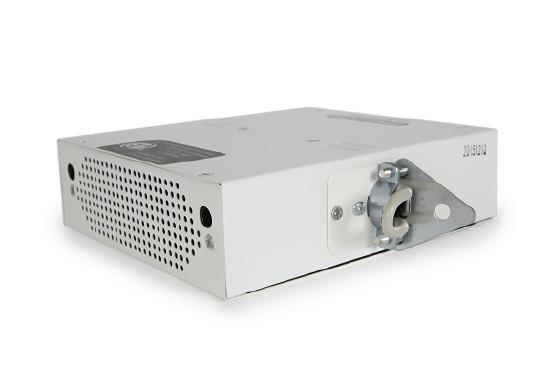 transformer with a tap switch ranging from 1/8 to 4 watts.
transformer with a tap switch ranging from 1/8 to 4 watts.
Note: 1 Watt is the recommended initial tap Setting for most sound masking applications
Cabling
The eight balanced line-level outputs should each connect to a single 70V/100V amplifier channel. Each amp output channel can in turn be connected to a line of 70V/100V sound masking speakers with standard two-conductor audio cable (#18 to #16 AWG). The maximum amount of speakers connected to a single amplifier channel depends on the power rating of the amplifier channel
Amplifiers
Any standard 70V/100V amplifier works, including the Revamp 1120T, 2120T, 4120T. Reveamp supports up to 50 Loudspeakers per amplifier channel (de-rated for sound masking signals)
Supported Qt X controllers
- Qt X 805 and Qt X 805D
Design considerations
Mixing Speaker Types in a Zone
Qt X systems support mixing speaker types within a Zone. While each output on a Qt X unit can only support a single speaker type, multiple outputs can be placed into the same Zone to share music, paging sources, and control. When designing Zones for a Qt X system, consider the needs of the space and why certain spaces share a Zone.
While multiple speaker or emitter types can share a Zone, some emitters still have limitations that would prevent them from sharing a Zone with other speaker types in certain situations. Passive emitters are not intended to be used in Zones with paging or Zones that need anything more than light music playback. Placing passive emitters in a Zone with paging functionality will inhibit the paging audio.
Ideal spaces
Passive Emitters
Should be placed in small- or medium-sized spaces where the speakers do not need to be hidden, and areas that use masking in addition to lower background music sources. For example, small lobby areas, hallways, or offices. The Standard Passive Emitter which has a maximum output of 56dBA for music and paging.
Active Emitters
Should be placed in small- or medium-sized spaces where the speakers don't need to be hidden and BGM playback or paging is needed. For example, small lobby areas, hallways, or offices that need music or paging. Active Emitters have a wider frequency range and has a maximum output of 74dBA for music and paging. If the environment has a higher noise floor and louder levels are needed from the emitter to produce audibly comfortable music, than the Active Emitter must be utilized as it is capable of producing higher levels of sound in the space.
Typical spacing of Passive and Active emitters relative to square footage:
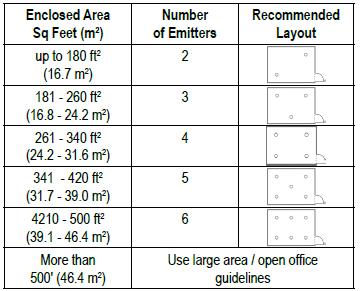
Low Impedance Speakers
Should be placed in small spaces where the speakers will be hidden and BGM playback or paging may be used. For example, personal offices or hallways.
70V/100V Speakers
For placement in small to large spaces where the speakers may need to be hidden or where large runs of speakers are needed, and where BGM playback or paging may be needed. For example, large open office areas, large event spaces, hallways, or lobby areas. The Qt X 805/805D controllers provide a cost-effective option for controlling large runs of 70V/100V speakers by using the Line Level outputs.
